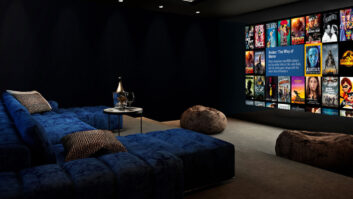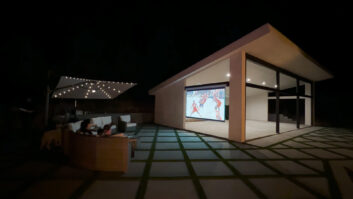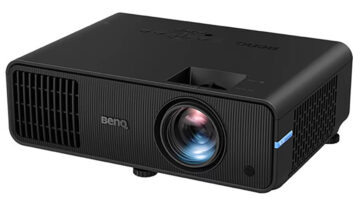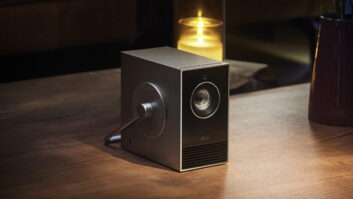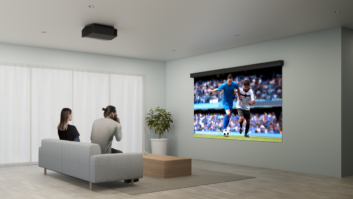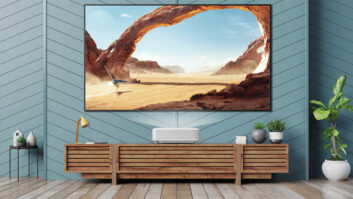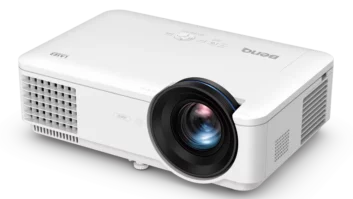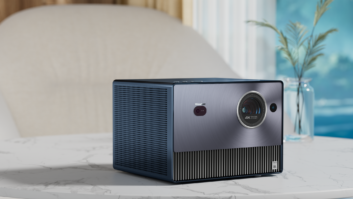I did a major car trash clean-up the other day, and I stumbled across a dusty old binder in my trunk. It was left over from the last time that I had to go and perform a Runco CRT calibration and it contained all of my notes for dialing knobs, turning switches, bullying phosphors, and making a three-lens RGB projection system look as good as I could.
So, I pulled the binder out and instead of just chucking it into the trash in its entirety, I flipped through and took a walk down memory lane. I received this binder back in August of 1999 when I received my “Certificate of Achievement” for passing Runco Technical Training. In the binder were a couple of things that I thought were incredibly noteworthy.

My Runco projection certificate from the bygone days
First, was a color sell-sheet for Runco “Anamorphic Optical Systems.” The sheet included the explanation that, “Runco International is a company that has always been committed to researching and developing innovative products, with one goal in mind – to deliver the ultimate home theater experience. Continuing the tradition, the company is proud to introduce their latest development, the Runco Anamorphic Optical System.”
Now, granted, today an anamorphic system is still a big whoop – I have one and I loves it; L-O-V-E, loves it – but it isn’t a GIANT whoop like it was when it first appeared. The crazy thing about this flyer is that it is copyrighted in 2000. Runco has been selling anamorphic systems for TEN YEARS now. If you ever wondered if they were pioneers of the high-end home theater trail, there it is. Pretty amazing.
Thing two was a sheet from Runco’s then national sales manager, titled, “Selling Front Projection Two Piece Video Systems for Home Theater.” Granted this is over 11 years old, so some of the advice hasn’t held up like the answer to this sales objection: “CRT projectors are an old technology and will be obsolete.”
Then answer: DTV is a new video signal that will provide an image with considerable more resolution than our current NTSC signal. Over 90 percent of the new DTV televisions are CRT technology. Runco CRT projectors have the resolution and horizontal scan rate to display all the DTV formats. Most of the CRT projectors have enough headroom to even display higher resolution signals if they are ever available. (PS: They ARE available. Now. And we call it 1080p. Pretty soon we’ll call it 4k.)
Today’s answer: Yes. They are. They are big and giant and dim and finicky and noisy and unless you are placing them into a room that is in the blackest-black of the deepest-deep space where a black hole would provide adequate reading light in comparison, then yes, they are obsolete. Also acceptable is that you just LOVE the idea of tinkering; where you find no greater thrill than jumping up in the middle of a movie and shouting, “Hold on a minute! Does anyone else see that Red CRT pincushion in the upper right corner?! Let me just – yeah, OK, here we go, a quick grid pattern, great, and here’s my tape measure, now some pin adjustment, now some keystone, now some pin balance and, yep, getting close, and…ah! Almost perfect! I better do a quick touch-up cal before we flip that laser disc over!”
Here are some of the highlights that I pulled from the “Selling” tips that are surprisingly true, even years later:
Initial Qualifying: The dealer has two objectives when qualifying a prospect: 1) Make sure the client has the budget to purchase a system. 2) Determine if the client’s home can accommodate a video projection system.
Now, these things are every bit as true today, but much easier to resolve. First, where a projector (Runco or otherwise) back in 1999 might have started at $10k but more realistically been $15-20k, today you can get a decent projector for around $5k and something pretty nice for $10k (again Runco or other). And where the light output of models then was measured in comparison to number of Bic lighters at a concert, today’s models are light cannons that, when coupled with newer screen technologies, can live in many different viewing environments. Or run a sweet-ass-sweet double display – plasma by day, projector by night! – set-up like I do.
Initial Demonstration: The four fundamentals in demonstrating video never change:
1) Thoroughly know your demo software material.
2) Tell them what they will see.
3) Show them.
4) Tell them what they saw. “Verbally paint them a picture of what they are going to see. ‘We are going to show a dark scene, as 60 percent of movies are done in dark scenes, notice the excellent picture detail in the dark scenes…”
I used to run a very formal demo of the Lucasfilm “Wow!” clip. I would explain what was going to happen, I would then start the clip, and I would excuse myself for the 12 or so minutes, and come back to the big finale. People loved it. It was an emotional demo that anyone could enjoy. In contrast to the time I showed the “skin melting off scene” from Terminator 2 when an old woman got up and walked out and then said, “Well! I can’t believe that anyone would want to watch that!” and me, in all my tact responded, “Well, your husband seems to be enjoying it.” Number of projectors sold that day: Zero point zero.
Demo Don’ts:
1) Don’t ask them how much money they want to spend. Usually the client is not aware how much money they are required to spend to get what they are looking for.
2) Don’t ever assume a customer can’t afford something.
3) Don’t give prospects more information than they need; that simply makes their decision making more complex.
4) Don’t try to overwhelm them with technical information – keep it simple.
The Second Demo: If the husband were not interested, there would be no second demonstration. The objective is to have the entire family embrace the home theater so the husband can justify the decision by amortizing the investment across the entire family. The concept of Home Theater is one that re-unites families in the increasingly limited time for common activities. As anyone who owns a real home theater can testify, children, wives, and husbands find equal and shared pleasure in watching a movie together.
I can think of no truer example of this than the experience we just had watching Toy Story 3 this past weekend. Surrounded by my wife and daughter and parents, it was a magical experience that would never have been the same on a 60-inch screen. When done right, the “big screen” experience can truly be magical. (Or make you weep like a baby…) Kaleidescape seems to have caught on to this idea as well with their simple children’s remote. If you can bring the kid’s into and get them vested in the experience, you can make the purchase easier for the family to justify. I think back to the number of times I dragged my wife around to various places in California to see projection system demos – Vidikron, Zenith, Runco, Sharp – before I was actually IN this business and wonder if someone had done a better job of engaging my wife, if we wouldn’t have pulled the trigger years ago… Food for thought when making my (your) next demo.
